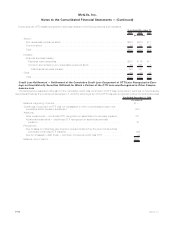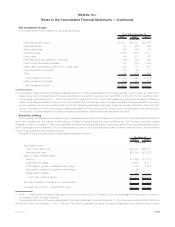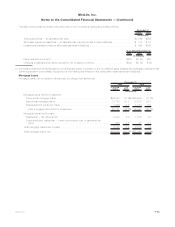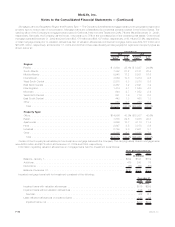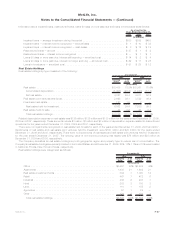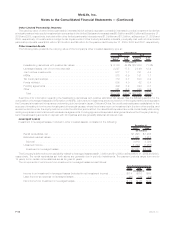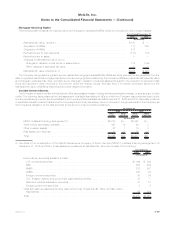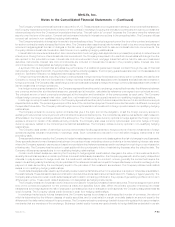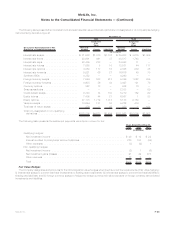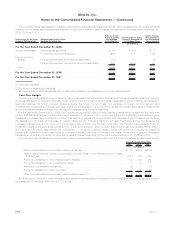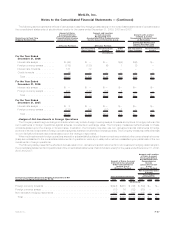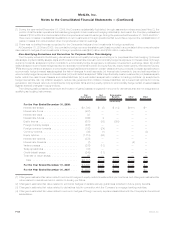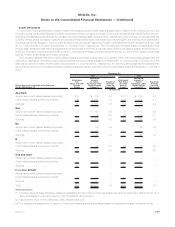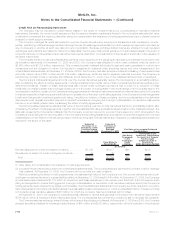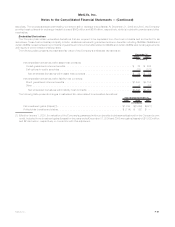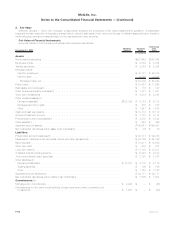MetLife 2009 Annual Report Download - page 136
Download and view the complete annual report
Please find page 136 of the 2009 MetLife annual report below. You can navigate through the pages in the report by either clicking on the pages listed below, or by using the keyword search tool below to find specific information within the annual report.
The following table presents the notional amount of derivative financial instruments by maturity at December 31, 2009:
One Year or
Less
After One Year
Through Five
Years
After Five Years
Through Ten
Years After Ten
Years Total
Remaining Life
(In millions)
Interestrateswaps..................... $ 2,509 $ 9,855 $16,498 $ 9,290 $ 38,152
Interest rate floors . . . . . . . . . . . . . . . . . . . . . 325 2,580 20,786 — 23,691
Interest rate caps . . . . . . . . . . . . . . . . . . . . . . 4,003 21,050 3,356 — 28,409
Interestratefutures..................... 7,563 — — — 7,563
Interestrateoptions .................... 200 100 3,750 — 4,050
Interestrateforwards ................... 9,921 — — — 9,921
SyntheticGICs........................ 4,352 — — — 4,352
Foreign currency swaps . . . . . . . . . . . . . . . . . . 880 8,290 4,588 3,121 16,879
Foreigncurrencyforwards ................ 6,485 — — — 6,485
Currencyoptions ...................... 822 — — — 822
Credit default swaps . . . . . . . . . . . . . . . . . . . . 112 5,910 701 — 6,723
Creditforwards ....................... 200 20 — — 220
Equityfutures ........................ 7,405 — — — 7,405
Equity options . . . . . . . . . . . . . . . . . . . . . . . . 355 22,007 4,384 429 27,175
Varianceswaps ....................... — 1,259 11,908 487 13,654
Totalrateofreturnswaps................. 376 — — — 376
Total............................. $45,508 $71,071 $65,971 $13,327 $195,877
Interest rate swaps are used by the Company primarily to reduce market risks from changes in interest rates and to alter interest rate
exposure arising from mismatches between assets and liabilities (duration mismatches). In an interest rate swap, the Company agrees with
another party to exchange, at specified intervals, the difference between fixed rate and floating rate interest amounts as calculated by
reference to an agreed notional principal amount. These transactions are entered into pursuant to master agreements that provide for a single
net payment to be made by the counterparty at each due date. The Company utilizes interest rate swaps in fair value, cash flow and non-
qualifying hedging relationships.
The Company also enters into basis swaps to better match the cash flows from assets and related liabilities. In a basis swap, both legs of
the swap are floating with each based on a different index. Generally, no cash is exchanged at the outset of the contract and no principal
payments are made by either party. A single net payment is usually made by one counterparty at each due date. Basis swaps are included in
interest rate swaps in the preceding table. The Company utilizes basis swaps in non-qualifying hedging relationships.
Inflation swaps are used as an economic hedge to reduce inflation risk generated from inflation-indexed liabilities. Inflation swaps are
included in interest rate swaps in the preceding table. The Company utilizes inflation swaps in non-qualifying hedging relationships.
Implied volatility swaps are used by the Company primarily as economic hedges of interest rate risk associated with the Company’s
investments in mortgage-backed securities. In an implied volatility swap, the Company exchanges fixed payments for floating payments that
are linked to certain market volatility measures. If implied volatility rises, the floating payments that the Company receives will increase, and if
implied volatility falls, the floating payments that the Company receives will decrease. Implied volatility swaps are included in interest rate
swaps in the preceding table. The Company utilizes implied volatility swaps in non-qualifying hedging relationships.
The Company purchases interest rate caps and floors primarily to protect its floating rate liabilities against rises in interest rates above a
specified level, and against interest rate exposure arising from mismatches between assets and liabilities (duration mismatches), as well as to
protect its minimum rate guarantee liabilities against declines in interest rates below a specified level, respectively. In certain instances, the
Company locks in the economic impact of existing purchased caps and floors by entering into offsetting written caps and floors. The
Company utilizes interest rate caps and floors in non-qualifying hedging relationships.
In exchange-traded interest rate (Treasury and swap) futures transactions, the Company agrees to purchase or sell a specified number of
contracts, the value of which is determined by the different classes of interest rate securities, and to post variation margin on a daily basis in an
amount equal to the difference in the daily market values of those contracts. The Company enters into exchange-traded futures with regulated
futures commission merchants that are members of the exchange. Exchange-traded interest rate (Treasury and swap) futures are used
primarily to hedge mismatches between the duration of assets in a portfolio and the duration of liabilities supported by those assets, to hedge
against changes in value of securities the Company owns or anticipates acquiring and to hedge against changes in interest rates on
anticipated liability issuances by replicating Treasury or swap curve performance. The Company utilizes exchange-traded interest rate futures
in non-qualifying hedging relationships.
Swaptions are used by the Company to hedge interest rate risk associated with the Company’s long-term liabilities. A swaption is an
option to enter into a swap with a forward starting effective date. In certain instances, the Company locks in the economic impact of existing
purchased swaptions by entering into offsetting written swaptions. The Company pays a premium for purchased swaptions and receives a
premium for written swaptions. Swaptions are included in interest rate options in the preceding table. The Company utilizes swaptions in non-
qualifying hedging relationships.
F-52 MetLife, Inc.
MetLife, Inc.
Notes to the Consolidated Financial Statements — (Continued)


